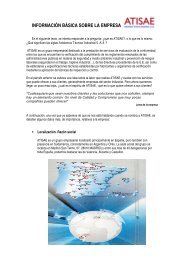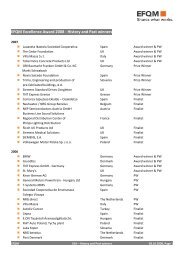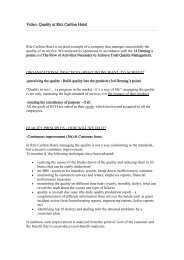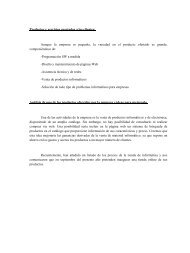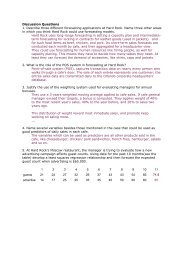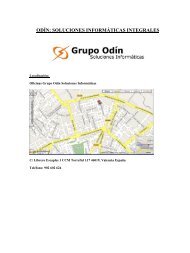Project presentation A case-study of ZARA Project ... - UPV
Project presentation A case-study of ZARA Project ... - UPV
Project presentation A case-study of ZARA Project ... - UPV
You also want an ePaper? Increase the reach of your titles
YUMPU automatically turns print PDFs into web optimized ePapers that Google loves.
<strong>ZARA</strong><br />
<strong>Project</strong> <strong>presentation</strong><br />
A <strong>case</strong>-<strong>study</strong> <strong>of</strong> <strong>ZARA</strong><br />
The Slitherers<br />
Michael Bijata<br />
Benjamin Buxton<br />
Enric Miralles Navarro<br />
Rubén Moreno Prósper<br />
Sonja Sanwald<br />
IPYGO 2009
<strong>ZARA</strong><br />
Description <strong>of</strong> general details <strong>of</strong><br />
the firm<br />
Task 1<br />
• Basic information: location, size,<br />
history, business sector,<br />
competitors, organizational<br />
structure<br />
IPYGO 2009
3<br />
Inditex Group<br />
• First Zara store opens in 1974 in La Coruña<br />
(Galicia).<br />
• One <strong>of</strong> the worlds largest fashion distributors<br />
• Eight “sales formats” - Zara, Pull and Bear,<br />
Massimo Dutti, Bershka, Stradivarius, Oysho,<br />
Zara Home and Uterqüe<br />
• Activities related to textile design, production<br />
and distribution<br />
The Slitherers - IPYGO 2009
4<br />
Facts and Figures<br />
• Half <strong>of</strong> employees work outside Spain<br />
• 83% female, average age <strong>of</strong> 26 years.<br />
• 4264 stores in 73 countries<br />
Fiscal Year 2007 2006 07/06<br />
Turnover (million<br />
€) 9,435 8,196 15%<br />
Net pr<strong>of</strong>it (million<br />
€) 1,250 1,002 25%<br />
Nº <strong>of</strong> stores 3,691 3,131 560<br />
Nº <strong>of</strong> countries 68 64 4<br />
International sales 62,5% 60,40%<br />
Employees 79,517 69,240 10,277<br />
The Slitherers - IPYGO 2009<br />
Source: Inditex
5<br />
Inditex Group Timeline<br />
First Zara store opens<br />
Logistics network<br />
created, designed for<br />
projected growth<br />
1963-74<br />
Amancio Ortega<br />
Gaona founds textile<br />
manufacturing<br />
business. Several<br />
centres distributing<br />
products to various<br />
European countries.<br />
The Slitherers - IPYGO 2009<br />
1975<br />
1985<br />
1986<br />
Creation <strong>of</strong> Inditex<br />
group
6<br />
Inditex Group Timeline<br />
Internationalisation <strong>of</strong><br />
business, with stores<br />
worldwide<br />
1988<br />
International<br />
expansion begins<br />
(Portugal)<br />
Stores in US/France<br />
1989<br />
1991<br />
Creation <strong>of</strong> Pull+Bear<br />
65% share in Massimo<br />
Dutti bought<br />
Total ownership <strong>of</strong> Massimo<br />
Dutti<br />
1990s<br />
1998/9<br />
Berhska created<br />
Stradivarius acquired<br />
The Slitherers - IPYGO 2009
7<br />
Inditex Group Timeline<br />
First online sales<br />
(only Zara Home)<br />
Two new logistics<br />
platforms<br />
2007<br />
2000s<br />
Creation <strong>of</strong> Oysho<br />
and Zara Home<br />
Public listing on stock<br />
market<br />
2008<br />
Creation <strong>of</strong> Uterqüe<br />
4000 th Inditex brand<br />
store opened<br />
The Slitherers - IPYGO 2009
Philosophy<br />
• Fast international expansion and excellent<br />
response to sales concepts.<br />
▫ “National borders are no impediment to sharing<br />
a single fashion culture.”<br />
8<br />
The Slitherers - IPYGO 2009
9<br />
Competitors<br />
• Mango<br />
• El Corte Ingles<br />
• H&M<br />
• Cortefiel<br />
• Arcadia Group<br />
(Burton, Dorothy<br />
Perkins, Evans,<br />
Miss Selfridge,<br />
Topman, Topshop,<br />
Wallis)<br />
• Benetton<br />
• Ralf Lauren<br />
• Tommy Hilfiger<br />
• Quicksilver<br />
• O’Neall<br />
• Guess<br />
• Gucci<br />
• Diesel...<br />
The Slitherers - IPYGO 2009
<strong>ZARA</strong><br />
Products, services and goods<br />
Task 2<br />
• Products and services delivered to<br />
customers.<br />
•Design <strong>of</strong> a new good (or redesign)<br />
<strong>of</strong>fered by the firm: Basic details, usage<br />
<strong>of</strong> production, design documents<br />
and House <strong>of</strong> Quality.<br />
IPYGO 2009
Products and services delivered to<br />
customers.<br />
• “Creativity and quality design together with a<br />
rapid response to market demands”<br />
• Mainly focused on clothing but spreading its<br />
activity in homeware and related items<br />
• From grandmother to grand-daughter, a catalog<br />
for everyone
12<br />
The new product<br />
• A new kind <strong>of</strong> t-shirt that fits<br />
both men and women<br />
• Basic Details:<br />
• Material: specially treated cotton<br />
that moves moisture away from<br />
your skin.<br />
• Design: special edition by a strange<br />
Japanese designer.<br />
• Sized: from XS to XXL to reach the<br />
widest market target possible.<br />
• Colour: Huge variety <strong>of</strong> colours to<br />
make it easy to find the one that fits<br />
your current clothes.<br />
The Slitherers - IPYGO 2009
<strong>ZARA</strong><br />
Quality management<br />
Task 3<br />
• Find some <strong>case</strong>s applications <strong>of</strong><br />
the quality tools selected and<br />
explained<br />
IPYGO 2009
14<br />
The Principle <strong>of</strong> Pareto<br />
• It says:<br />
▫ 20% <strong>of</strong> the costumers will buy 80% <strong>of</strong> the clothes sold<br />
▫ 80% <strong>of</strong> the costumers will buy 20% <strong>of</strong> the clothes.<br />
• We will identify this<br />
20% who spend<br />
more, and attract<br />
them<br />
80%<br />
• Also: 20% <strong>of</strong> our<br />
articles are sold 80%<br />
more than the others.<br />
▫ identify and<br />
manufacture these<br />
20% <strong>of</strong> the<br />
more than others<br />
causes<br />
The Slitherers - IPYGO 2009
15<br />
Scatter Plot<br />
3000<br />
• The Scatter Plot is very<br />
useful to view the correlation<br />
between different kind <strong>of</strong><br />
aspects which affect the<br />
company. One example <strong>of</strong> this<br />
is to relate the number <strong>of</strong> sales<br />
<strong>of</strong> swimming trunks with the<br />
months <strong>of</strong> the year.<br />
Sales<br />
2500<br />
2000<br />
1500<br />
1000<br />
500<br />
0<br />
1 2 3 4 5 6 7 8 9 10 11 12<br />
Month<br />
The Slitherers - IPYGO 2009<br />
Month J F M A M J J A S O N D<br />
Sales 3 2 100 30 75 3000 1500 1000 3 6 8 1
16<br />
Control charts<br />
• We can use them to measure<br />
some sorts <strong>of</strong> quality <strong>of</strong> the<br />
clothes like the resistance <strong>of</strong><br />
the seams.<br />
• The quality <strong>of</strong> article is a<br />
random variable and the<br />
percentage <strong>of</strong> articles<br />
defectives depends <strong>of</strong> the<br />
distribution <strong>of</strong> these random<br />
variables.<br />
The Slitherers - IPYGO 2009
17<br />
Customer comes<br />
into store<br />
Flow Chart<br />
• A can be very useful in our<br />
own company, for example for<br />
to give advise to our employees<br />
about how to behave in front<br />
<strong>of</strong> potential customers<br />
Cause-and-effect<br />
says a tiny changes in our<br />
stores can achieve some effects<br />
which will increase the sales.<br />
For example if in the places<br />
where there are male clothes<br />
there are woman helping and<br />
vice-versa the sales will<br />
increase.<br />
Looks like (s)he<br />
is going to buy?<br />
Yes<br />
Is (s)he young?<br />
Yes<br />
Be cool<br />
No<br />
No<br />
Don’t talk<br />
to him/her<br />
Be respectful<br />
The Slitherers - IPYGO 2009
<strong>ZARA</strong><br />
New product strategy<br />
Task 4<br />
• Select and describe the process suitable<br />
strategy for the product and service designed<br />
in Task 2.<br />
• Process Analysis and Design Questions<br />
IPYGO 2009
19<br />
Process strategy<br />
• Chosen strategy: mass customization<br />
(takes advantage <strong>of</strong>: repetitive focus, process focus and product focus)<br />
▫ High volume (but low volume per single shop),<br />
▫ High variety (many different models and sizes),<br />
▫ Very short product lifecycle (to meet the particular<br />
customer’s needs and fashion)<br />
• Modular design (e.g. some products have mutual<br />
patterns)<br />
• Lean production<br />
• Effective scheduling<br />
• Rapid logistics (JIT model)<br />
• Short selling time<br />
The Slitherers - IPYGO 2009
20<br />
Flow diagram <strong>of</strong> production process<br />
The Slitherers - IPYGO 2009
21<br />
Equipment and technology used<br />
• Production equipment:<br />
▫ Flexible Manufacturing System (FMS)<br />
• Advanced production management & scheduling system,<br />
▫ The most efficient machinery combined with the manual<br />
production,<br />
▫ Robots,<br />
▫ Quality control machinery<br />
• Logistics:<br />
▫ Automated storage and retrieval system,<br />
▫ Advanced tracking & scheduling system,<br />
▫ RFID identification,<br />
• Design:<br />
▫ All products designed with CAD s<strong>of</strong>tware.<br />
The Slitherers - IPYGO 2009
22<br />
Competitive advantage<br />
• Product’s competitive advantage achieved on the basis <strong>of</strong><br />
product differentiation strategy mixed with innovative<br />
processes design.<br />
▫ Differentiation:<br />
• Superior design,<br />
• Quality,<br />
• Marketing (the brand),<br />
• Medium price.<br />
▫ Innovative processes design:<br />
• Incredibly short Product Life Cycle (product is being designed<br />
3 weeks before it gets to the shops)<br />
• Extremely fast logistics (including JIT system)<br />
• Low product volume per shop (clients can’t wait for the sales,<br />
higher margin)<br />
The Slitherers - IPYGO 2009
23<br />
Environmental sustainability<br />
• Product’s materials fulfilling all <strong>of</strong> the<br />
environmental standards,<br />
• Use as many recycled materials as possible (if<br />
they fulfill the quality requirements),<br />
• Materials as recyclable as possible,<br />
• Taking into account the environmental impact<br />
through the whole life cycle <strong>of</strong> the product.<br />
The Slitherers - IPYGO 2009
24<br />
Questions for Process Analysis and<br />
Design<br />
• Is the process designed to achieve competitive advantage<br />
in terms <strong>of</strong> differentiation, response, or low cost?<br />
▫ Yes, in terms <strong>of</strong> differentiation.<br />
• Does the process eliminate steps that do not add value?<br />
▫ Yes, the processes concentrate on adding value.<br />
• Does the process maximize customer value as perceived<br />
by the customer?<br />
▫ Yes (short life cycle, lean production, more adjusted<br />
product design)<br />
• Will the process win orders?<br />
▫ Yes, it already does win the orders.<br />
The Slitherers - IPYGO 2009
<strong>ZARA</strong><br />
Technology and its benefits<br />
Task 5<br />
• Analyze and describe the tech side<br />
<strong>of</strong> your company.<br />
• Reflect about the possibilities<br />
<strong>of</strong> Internet as a channel<br />
distribution for your products.<br />
IPYGO 2009
26<br />
• Production Process<br />
▫ Mass-production for cheaper raw materials<br />
and production<br />
▫ Production in Low Cost Countries<br />
• Hi-tech facilities<br />
▫ Dye and cut fabric<br />
▫ Compatibility <strong>of</strong> the machines<br />
▫ Automatized production<br />
The Slitherers - IPYGO 2009
27<br />
• Use <strong>of</strong> computers to interactively design<br />
products and prepare engineering<br />
documentation<br />
• Centralized decisiones about design (colour,<br />
material, <strong>presentation</strong>,…)<br />
• Centralized acting <strong>of</strong> the purchasing department<br />
(prices, locations, materials,…)<br />
The Slitherers - IPYGO 2009
28<br />
• Integration <strong>of</strong> traditional internal information<br />
systems as well as enhancement <strong>of</strong><br />
communication between organizations<br />
• Internet-based systems to realize global<br />
manufacturing, delivery, and after-services<br />
activities<br />
• Combination <strong>of</strong> Internet and e-commerce to<br />
improve the value delivered to the customer,<br />
interacting with suppliers, and managing its<br />
employees<br />
The Slitherers - IPYGO 2009
29<br />
• Less time for development <strong>of</strong> new products with<br />
virtualization<br />
• technical collaboration and transfer <strong>of</strong><br />
information to and from the provider<br />
• Improved information systems and<br />
enhancement <strong>of</strong> communication between<br />
organizations and the different locations <strong>of</strong> the<br />
company<br />
The Slitherers - IPYGO 2009
30<br />
The Webpage <strong>of</strong> <strong>ZARA</strong><br />
• Online Catalog<br />
• New products<br />
• Fashion News from all over the world, tailored to<br />
the particular needs <strong>of</strong> <strong>ZARA</strong><br />
• Motivation <strong>of</strong> the consumers to buy someting<br />
• Information about the nearest shop<br />
• Customer service (exchanging <strong>of</strong> products,<br />
ordering <strong>of</strong> customer cards…)<br />
The Slitherers - IPYGO 2009
31<br />
Possibilities <strong>of</strong> e-commerce<br />
• Online shop<br />
▫ Guaranteed actuality<br />
▫ Customer Relationship Management<br />
• User accounts<br />
• Newsletter<br />
• Feedback forms<br />
• Online shipment tracking<br />
• Cost savings<br />
▫ Less personnel<br />
▫ Possibility <strong>of</strong> locating the warehouse in cheaper<br />
areas<br />
The Slitherers - IPYGO 2009
<strong>ZARA</strong><br />
New technology in business<br />
Task 6<br />
• Consider the implications <strong>of</strong><br />
Twitter for your business.<br />
IPYGO 2009
• What is twitter?<br />
▫ Online real-time microblogging service<br />
▫ Short-messaging (140 characters max)<br />
▫ Broadcast type (no need to answer)
• Not yet widespread<br />
• Possible uses:<br />
▫ Shop to warehouse<br />
▫ Warehouse to warehouse<br />
▫ Client to shop<br />
▫ Group mates
• Pros<br />
▫ Saves time:<br />
• non responding<br />
destinators<br />
• Short message – short to<br />
read<br />
▫ Higher performance<br />
▫ Faster<br />
response time<br />
• Cons<br />
▫ Wireless infrastructure<br />
needed<br />
▫ Twitter-dependency<br />
▫ Many other<br />
communication ways<br />
already in use<br />
▫ Not widespread
<strong>ZARA</strong><br />
Thanks for your attention<br />
Any questions?<br />
http://ipgo.webs.upv.es/the_slitherers/<br />
IPYGO 2009




